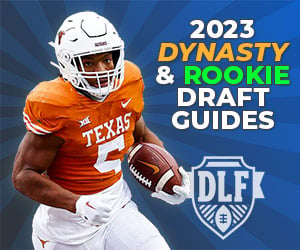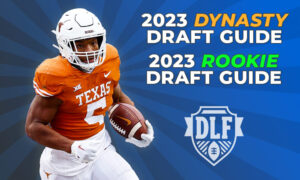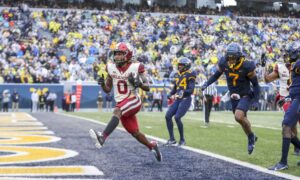The topic of rebuilding in dynasty is always a fascinating one. I feel as though we throw the term around when discussing any team that isn’t currently competing and has a few picks. Debates rage on about how long a rebuild should take or how to properly execute the move. Some give examples, with others just offering statements that have no actual advice or supporting data.
In this article, I want to tackle what exactly I believe it means to rebuild, tips on how to execute the move and milestones you should be looking at as a manager to measure the success or failure of a rebuild. This will be part of a series of dynasty strategies that I have compiled in my years of player dynasty and being moderately successful. As always, challenge anything and adapt any advice to fit your particular league or style. None of this is to suggest there is only one way to get to the finish line, this is simply how I execute the move and judge myself once complete.
Step 1: Do you need to rebuild?
Obvious, right? You should really have an understanding if a rebuild is necessary before even taking on the task. The only way to understand is to have the foundation skill of any good fantasy manager and know your leaguemates.
First look at the other rosters in the league. Are you able to compete over the next few years?
Be honest with yourself here, if there is a young juggernaut roster poised to dominate the league for the next two years, acknowledge that and take note. Write down some options you would need to acquire to close the gap and see if that is possible with your current cache of assets. Rebuilding should only be done where necessary so try to find a way to compete first and foremost.
If your list is currently six players long and you are looking at nothing more than two second-round picks in the next two seasons, you probably have your answer. But make sure you don’t skip this step in the process so you are certain you want to do what comes next.
Step 2: Is now the right time?
You would be amazed how often this step is totally overlooked. The collective self-centered view of fantasy football is something that is so easy to spot (and therefore exploit). Just because you can’t compete doesn’t mean it is time to tear it down completely. Your roster still has assets that will need to be moved and timing is everything when pulling off a successful rebuild.
- Are there any other rebuilds currently in flight?
- What do the current and subsequent draft classes look like?
- When will your assets be at peak value?
While I am possibly stating the obvious for some, let’s outline why these three questions matter and how to properly answer them to help identify if now is the time to pull the trigger on your tear down and rebuild.
Are there any other rebuilds currently in flight?
It isn’t hard to spot a rebuild with just a quick scroll of the recent transactions in your league. Multiple win-now assets being traded for picks, young players and devy assets are always a dead giveaway. Reviews of rosters and seeing one that looks more like a daycare than a place of business will also tell you all that you need to know. But why is this important?
Simple supply and demand. There are only so many assets to go around and the more that are already spoken for, the less that remain for you. Further, the more bidders you have on a potentially available asset, the higher the cost of acquisition.
So take a look at the transactions, rosters and future draft pick ownership to see if someone beat you to the punch. The last thing you want to be is the worst rebuild in the league. You will be swimming upstream for years if you time this poorly so make sure you understand your surroundings.
What does this current and subsequent draft class look like?
If you are playing dynasty and not devy, where rookies are only available when they are officially in the NFL, your most likely path to success is through draft picks. While you might be able to pick up some young players, young stars aren’t being dealt by competing teams for aging assets of the same production. That is just bad business.
This is why an understanding of incoming draft classes is so important. While there is a 1.01-1.12 (or however many teams you have in your league), the value of those picks differ greatly from year to year. My last rebuild was in 2019 when I was able to acquire picks in the historic 2020 draft which led to Jonathan Taylor, D’Andre Swift and Antonio Gibson. If you pulled off the same move a year earlier, the results could have been far less desirable and would hardly result in a league winner.
The beauty of being a DLF subscriber is that you have access to Devy Rankings that will help you clearly see what class the top devy assets are eligible for. This knowledge is power!
Now going back to the previous point, make sure someone has already begun hoarding the picks from the class you are targeting. You just did a ton of research but it might just be too late and that happens. Bury that emotion and rethink your next steps.
When will your assets be at peak value?
If you have gone through the decision tree above and still think rebuilding is the right move for you, it is time to analyze your own roster to figure out how to maximize your trade return for each asset to ensure you come out on the other side with the most valuable roster possible.
Let’s start with the players on your roster as that is a very simple process. How did they perform last year compared to their expected output in the current year? In September of last year, you could easily have gotten Cooper Kupp for Allen Robinson straight up. Try making that deal now and let me know how that goes.
Obviously in this example, Kupp would be an asset I would look to move now in a deal as he is coming off a historic season while Robinson I would take a wait-and-see approach as it truly couldn’t get much worse.
Take this thought process to your entire roster to determine when to strike so that you can get peak value for each piece. You only get one chance to trade a player so make it count!
As for picks, that is a far more straightforward approach. If you can, wait until after the rookie draft when the picks will hit peak value. Right now, it is just a number but once people can see a clear path to carries or targets, they will come looking to get in on the action. It may seem counterintuitive to trade picks if you are planning a rebuild, but again the goal is to maximize the value of your roster. That could mean moving the pick for an underperforming young player poised for a breakout or to trade into a draft class with higher-end talent. Keep an open mind on all the assets you have available to make moves.
I’ll cover this in far greater detail as part of the ‘Trade Strategy’ article coming out soon, but I wanted to make sure you set your mindset to properly use the tips in that article for your rebuild process.
Step 3: Set Goals and Milestones
We all know those rosters that seem to be in a constant rebuild with no end in sight. The constant kicking of the can down the road because they have no exit strategy. I am not sure there is any worse place to be in dynasty than lost at sea like this. That is why formulating a rebuild like a project is so important.
Any decent project manager will tell you that a project can’t even kickoff with measurable goals and milestones in place. This will avoid emotional decision-making in-flight and ensure that everyone is aware of the current status of the overall project throughout the process and not just at the end where success or failure has become obvious.
So let’s talk about the timeline of a rebuild first. I am of the belief that a well-timed rebuild should take no more than two years. That is why we do all the prep work above upfront. Striking fast and before the league has a full picture of your plan will set you up to flip that roster for young assets quickly.
Your goals are simple:
- Capitalize on leaguemates’ bias or desperation
- Set your roster up in a way that is either set to win as is or hold enough value that you can trade the pieces to build a winner
- If you fail, fail fast and adjust
If you are in a superflex, desperation is easy to spot at the quarterback position. Sell veterans like Aaron Rodgers or Matthew Stafford to those who are looking to upgrade. Knowing your league mates as we discussed above should have you ready to play.
As far as bullet two, never lose sight that the point is to win! The young assets you acquire don’t have to equal a championship, they simply have to provide you a path to one. Heck, you might even acquire back some of the older pieces you moved as part of the rebuild later in the process (for a handsome profit of course!).
And lastly, recognize your failures. If you acquired picks and blew them all because you don’t know how to analyze incoming rookies, this might not be the right strategy for you or you need to learn how to improve that skill. But whatever you do, don’t keep burning picks without being self-aware of how you are and what you can do.
So after your first flurry of activity, you should hit an important milestone:
All assets you deemed were at peak value should have been cashed in leaving only assets you expect to gain in value during the season or assets that you will use in the actual rebuild left.
Have a trade deadline? Well, we just found milestone number two:
Now all assets you expected to gain value should be reviewed and determined if you were correct. Honestly this is where you might either be selling high or selling low. Either is fine, it happens. Just never be stuck holding the bag in a rebuild. That is a rebuild killer.
Last milestone:
Can you turn this roster into a competitor? When you are ready, it is time to run the whole game plan in reverse! Many of the same steps should be taken, just with an eye on winning it all now.
If executed properly, a full rebuild is probably the most fun thing you can do as a dynasty player. The frustration only comes in when you realize you are spinning your wheels. I hope this article helps you avoid that frustration. Happy rebuilding! And keep an eye out for more strategy articles coming this off-season.
- Dynasty Fantasy Football Strategy: Bankroll Leagues - July 28, 2022
- Dynasty Fantasy Football Strategy: Rookie Drafts - May 16, 2022
- Dynasty Fantasy Football Strategy: Startup Drafts - April 21, 2022

Enjoyed the article, as it was quite analytical compared to similar ones I’ve read. One question, you mentioned look around and if another team has beaten you to the punch, rethink. What is the go forward strategy then? Thx!
Thanks, it absolutely does!
Great article and thank you. Had a totally win now roster last year and started off 1-6 so i kicked into a rebuild. Ive been able to secure 3 firsts in 22 (1.06, 1.07, 1.08) and 3 firsts and 2 2nds in 23 (very excited about this. I already have some young talent in J Herbert, Etienne and Akers (bought them on injury discounts) and Hockenson. So i think its going pretty well, we will see. One thing id add to the article is if you are rebuilding try to go after injury discount players.
Love this! It would help so many leagues if some owners knew when it was time to rebuild. Some just drive it into the ground, get upset looking at their teams, then quit. Start that rebuild while you can! Good article.
Knowing your league mates and timing is so critical. Great article.















